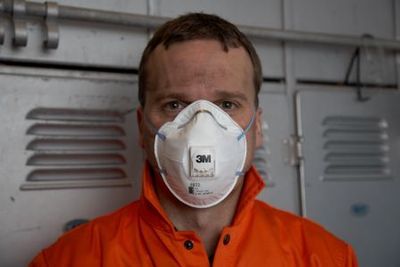Respiratory protection against exposure to diesel particulate
Wednesday, 01 August, 2012
On 12 June 2012, the International Agency for Research for Cancer (IARC), which is part of the World Health Organisation (WHO), changed its classification of diesel exhaust from Class 2A (probably carcinogenic to humans) to Class 1 (carcinogenic to humans).
This classification was based on sufficient evidence that exposure is associated with an increased risk for lung cancer.
Diesel engines are widely used to power vehicles and equipment. The exhaust from these engines exposes workers to a complex mixture of airborne contaminants in both gaseous and particulate forms. This mixture can create a respiratory hazard for workers.
There are many gaseous components in diesel exhaust and some of these will be incorporated into the carbon soot particles created in the exhaust. However, the exhaust can also include significant levels of various gas/vapour components. The state of tune of the diesel engine can have a significant effect on the relative makeup of the exhaust - with cold, poorly tuned and worn engines releasing more unburned or partially combusted fuel as well as diesel particulates.
Health effects
Acute: Symptoms associated with acute/short-term exposures include headache, nausea, dizziness, cough, bronchitis, irritation of eyes, nose, throat as well as trigger an asthma attack.
Chronic: Potential longer term effects include cardiovascular disease, stroke, high blood pressure, emphysema, lung and bladder cancer.
Reducing exposure to diesel particulate
Suitable means and methods of reducing worker exposure to the effects of diesel particulate in a work environment are available. Improvements in engine technology (catalytic converters), exhaust filters and low-sulfur fuels designed to reduce emissions and use of scrubbers to improve air quality are all means of reducing the respiratory hazard for workers.
Additionally, the wearing of a P2-rated respirator is an effective means of reducing worker exposure to diesel particulate. The selection of a filter that includes an added carbon layer helps to remove odours associated with unburned fuel and other combustion components of the exhaust which can become breathable organic vapours.
Importance of fit testing
One of the biggest contributors to reduced respiratory protection is poor fit. The AS/NZS1715:2009 Standard states that fit testing is mandatory for all users of tight fitting facepieces - workers who use these should be trained, fit tested and clean shaven. To ensure effective fit of disposable and re-usable respirators, 3M has Qualitative Fit Test Kits available.
Suggested 3M respirators that protect against diesel particulate
The following respirators represent one product from each of 3M’s three respirator ranges: disposable respirators, re-usable respirators and powered and supplied air respirators. There are other products available to select from 3M’s comprehensive offering of respiratory protection.
- 3M Cupped Particulate Respirator 8822, P2, Valved - With a P2 rated filter and unique exhalation valve, this respirator is suitable to assist in reducing exposure to diesel particulate in workplace situations.
- 3M Half Face Respirator 7500 Series with 3M Particulate Filters 2128, GP2 - The particulate filter provides P2 protection for diesel particulate and has additional carbon which reduces exposure to odours and unburned fuel vapours produced by poorly tuned diesel engines.
- 3M Airstream Powered Air Purifying Respirator (PAPR) - A rugged Australia/New Zealand Standards-compliant respiratory protection system that provides integrated high-impact head, eye and face protection. The helmet offered with optional P2 filter with added carbon for odour removal is suitable for work environments where airborne diesel exhaust fumes may be present.

Information about its respiratory range or technical assistance on 3M respirators that protect against diesel particulate can be obtained from 3M.
Atmosphere, access and rescue — confined space safety beyond compliance
Working at Height Association CEO SCOTT BARBER explains the importance of a whole system of...
The benefits of complying with new welding fume safety standards
As Australian welding safety regulations become more stringent, workplaces should look to deploy...
Six steps to ensure mining contractor safety
Hazardous working conditions and complex operations demand rigorous safety protocols within the...









